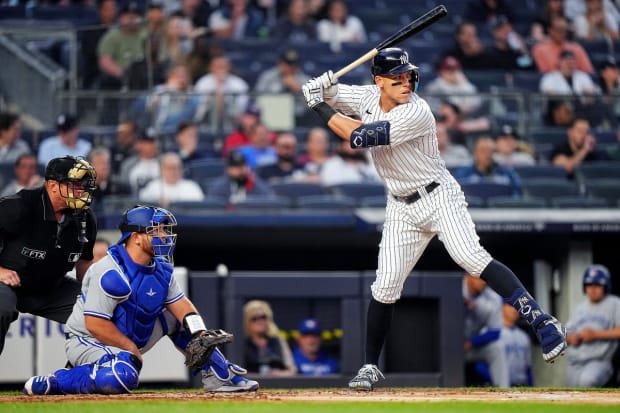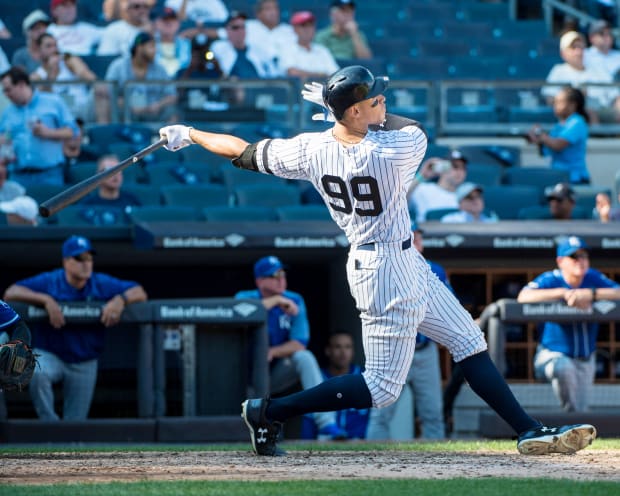During a road trip to his home state over the past week, Aaron Judge continued his historic home run chase. When the Yankees’ slugger went yard on Monday against the Angels, he became the seventh different player ever to hit 50 homers before September. The following night, he launched No. 51.
Judge has virtually no chance of equaling Barry Bonds’s single-season record of 73 home runs, but that shouldn’t diminish what he is doing this season. The top six single-season home run totals are all attributed to Bonds, Mark McGwire and Sammy Sosa, three players who used performance-enhancing drugs (In 2012, McGwire admitted to using steroids during his career; Bonds and Sosa have denied it, but there is strong evidence that they took PEDs.) The seventh-highest total of 61, however, belongs to former Yankees great Roger Maris, who holds the American League record for the most single-season homers. Judge and Maris are the only two AL players to reach 50 home runs before September.
Sixty-one still carries weight in baseball as the “clean” home run record, and it’s well within reach for Judge. After launching 51 home runs in New York’s first 131 contests, Judge needs 11 home runs over the final 31 games to pass Maris; he’s on pace for 63. The 30-year-old has racked up five long balls in his last nine games, so he certainly doesn’t seem to be slowing down.
Judge has a lot of things working in his favor when you consider the context of his season compared to the other sluggers who hit 50 before September. Because the season started a week late due to the lockout, he has more games left at this time of year than the others.
Only two players who hit 50 homers by September ended up not reaching 61 (though it’s worth noting the success rate is 1-for-3 for those not credibly linked to PEDs). Unlike the other players on this list, Judge also has the advantage of getting some of his plate appearances at DH if Yankees manager Aaron Boone wants to rest him in the field. Everyone else either played in the National League before the universal DH was instituted this season or, as Maris did, played before the DH was instituted at all. Judge has filled the DH role 19 times so far, and he’s only sat out for the entirety of a game four times. Until he passes Maris, he’ll almost certainly hit every day, barring injury.
Let’s see what unfolded for the four hitters on the path most similar to Judge in terms of the pace they set over the course of the season and how many games each had left entering September.

Erick Rasco/Sports Illustrated
Roger Maris (1961)
Yep, we begin with the ghost Judge is chasing—the home run record unstained by PEDs. Maris famously didn’t leave the yard in his first 10 games and had only a dozen by the end of May. But a monstrous summer had him standing at 51 home runs with 30 games to go, while Judge is at 51 with 31 games left.
Maris had a few bursts throughout September—a two-homer game against the Tigers on Sept. 2, three in four games from Sept. 6 to 9 and three more in a five-game span from Sept. 16 to 20—that put him at 59 with eight games to play. But the day after Maris hit No. 60 to tie Babe Ruth’s single-season record on Sept. 26, the Yankees kept him out of the lineup for the first and only time that season, despite New York’s having four games left to play and an off day on the 28th. It was an extremely stressful time for Maris, who hadn’t been embraced by fans as dearly as the two Yankees icons he was contending with for the record: Ruth, whose record had stood for 31 years and whose cultural clout weighed on Maris through much of the season, especially over the final month; and teammate Mickey Mantle, who was also chasing Ruth’s record before a hip injury—and subsequent infection due to an injection to cure the injury—slowed his pace and eventually kept him out of the lineup.
Maris failed to get a hold of one in either of the first two games of New York’s season-ending series against the Red Sox. But he succeeded in dramatic fashion in the fourth inning of the season’s final game, turning on a 2–0 fastball from rookie Tracy Stallard to finish his quest and provide the only run in a shutout win for the eventual World Series champions.
When Maris surpassed Ruth, MLB commissioner Ford Frick declared that he wasn’t the official record holder because he’d needed eight more games to beat The Bambino—Frick had just expanded the schedule from 154 to 162 games ahead of the season to coincide with the American League increasing from eight to 10 teams. “The Asterisk,” as it was called, wasn’t removed until 1991, five commissioners after Frick and six years after Maris’s death. It would be interesting to see whether Judge’s 62nd home run would be treated with a different sort of asterisk if he can claim the “clean” crown.
Sammy Sosa (2001)
At this point, Sosa was a beloved superstar who’d already captivated the nation with his first successful bid to pass Maris alongside McGwire three years earlier. But the spotlight was largely off of him during this period because of Barry Bonds’s ongoing rewriting of the record books in San Francisco, in addition to the 9/11 attacks that shut down baseball for a week.
Sosa had crushed 17 home runs in 29 August games, coming up one short of the August record set by Detroit’s Rudy York in 1937 and that would be matched by Stanton 16 years later. But the then-33-year-old hit a cold period before 9/11, tallying just one in his last eight games before the most infamous day in modern U.S. history. After every team took a week off to mourn, Sosa eventually got back on track with three home runs off of Astros rookie Tim Redding on Sept. 23, becoming the first player in MLB history to hit three homers in a game three times in one season. He ripped only one in his next seven games—with that lone trot counting as one of his most famous trips around the bases—then finished on a tear with five in the Cubs’ final six games, against the Reds and Pirates at Wrigley Field, to finish with 64.
That 2001 season was the third one in which Sosa hit at least 60 home runs, making him the only player in MLB history to reach that mark as many times. Remarkably, Sosa had the second most homers in each of those three years, which speaks to the era’s offensive environment. This year, it’s Judge and then everybody else. Phillies slugger Kyle Schwarber leads the NL in dingers with 36, while Houston’s Yordan Alvarez, who ranks second in the AL, is 20 behind Judge entering September. This is all to say the context surrounding Judge’s 51 homers this year is different than it was for Sosa in ’01, as well as in Sosa’s three other 50-homer seasons (1998, ’99, ’00).
Whether it’s Sosa’s PED use, the weeklong break or the eras in which they played, the circumstances for Sosa’s ’01 season make it more difficult to draw any definitive conclusions about where Judge will end up. But Sosa’s impressive final week represents the sort of output Judge might need to replicate at some point over the next month to eclipse Maris.
Luis Gonzalez (2001)
Even though Gonzalez was one of three players in ’01 on pace to at least match Maris’s record heading into September, he’s best known for something else he accomplished at the plate that year that’s even more remarkable—coming out on top against Mariano Rivera in Game 7 of the World Series to give the Diamondbacks their first and only title.
While Gonzalez entered September with 51 homers, he had four fewer games remaining than Judge does. The larger obstacle for his bid was that he simply didn’t have the same sort of power pedigree as his peers on the above table. While Judge cranked 52 round-trippers in his rookie year, Gonzalez never topped more than 31 aside from this 57-homer outburst. He has never been credibly linked to steroids, but because of his ’01 power surge and the era in which he played, some people still are skeptical of his accomplishments. Then again, Maris had just three 30-home run seasons in his career, and they all came in consecutive years—he hit 39 in 1960, 61 in ’61 and 33 in ’62. Some of the best home run hitters in history—Henry Aaron, Albert Pujols, Frank Robinson, to name a few—never hit 50 in a single season. Eddie Murray, who retired with 509 homers, never had more than 33 in a season, and only three times had more than 31. The point is it’s incredibly difficult for any hitter to sustain this level of power, over a six-month season, let alone do it across multiple years. Judge is one of 10 players to reach the 50-dinger mark at least twice in his career.
Gonzalez fell back to earth right around the time he turned 34 on Sept. 3, failing to homer in the first eight games of the month before the weeklong break after 9/11. Even after the week of rest, he hit just two round-trippers in his first 10 games back. That left him with too big of a mountain to climb, as the four homers he managed in Arizona’s final nine games still left him with just six home runs over the final month’s worth of games in September and October, his lowest monthly total of the year.
Still, he’s probably happy with how his season ended.

Gregory J. Fisher/USA TODAY Sports
Giancarlo Stanton (2017)
Stanton roared into September even hotter than Sosa did in 2001. Then in his final season with the Marlins, Stanton hit 18 home runs in August, which is by far the highest monthly total of his career, after he started off with just seven apiece in April, May and June. That didn’t carry over into September, though, as he went 9-for-53 (.170) with 10 walks and three homers in his first 15 games that month.
He entered the second to last series of the season—a three-game set vs. the Rockies at Coors Field—needing four home runs to tie Maris, but he went 1-for-12 with four strikeouts and a double in Colorado. The Marlins finished the season with four home games against Atlanta. Stanton mashed two dingers in the first game of the series, putting him within another pair of tying Maris with three to play and leaving open the possibility that he could get there. The Braves didn’t exactly shut down Stanton from there—he went 5-for-14 with four singles and a double in the final three contests—but they kept him in the yard.
Hitting 59 home runs was good enough to earn the NL MVP and tie Babe Ruth’s 1921 season for ninth-most all-time—in addition to being the most since 2001—but it wasn’t enough to stamp it as a truly historic season. The chase did, though, leave Marlins fans with some fond memories of the franchise’s most prolific slugger just months before he was traded to the Yankees that December.
Judge enters September with two more games to play than Stanton had in 2017 and the same number of homers. As was the case with Stanton, Judge’s push for 61 is going to be tight. He’s on track to make it, and as he has proven throughout this season, it’d be unwise to bet against him.
!["[T]he First and Fifth Amendments Require ICE to Provide Information About the Whereabouts of a Detained Person"](https://images.inkl.com/s3/publisher/cover/212/reason-cover.png?w=600)






